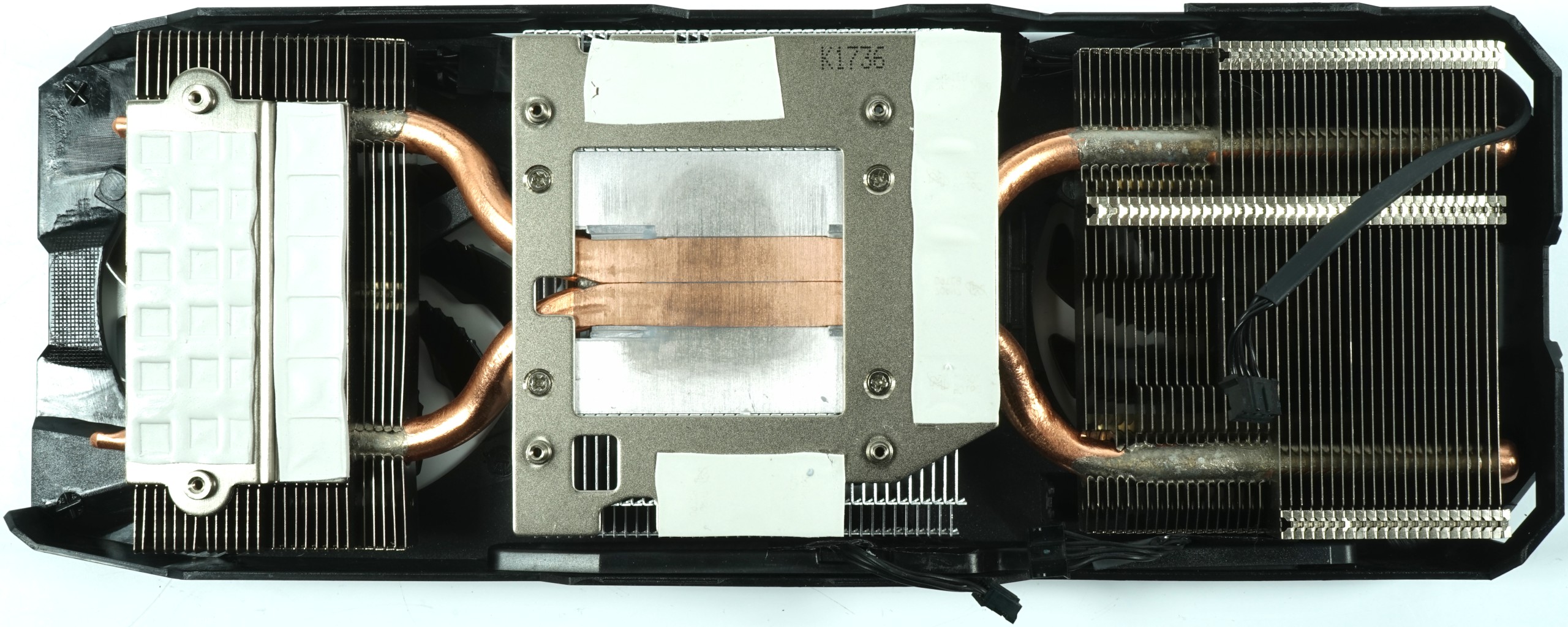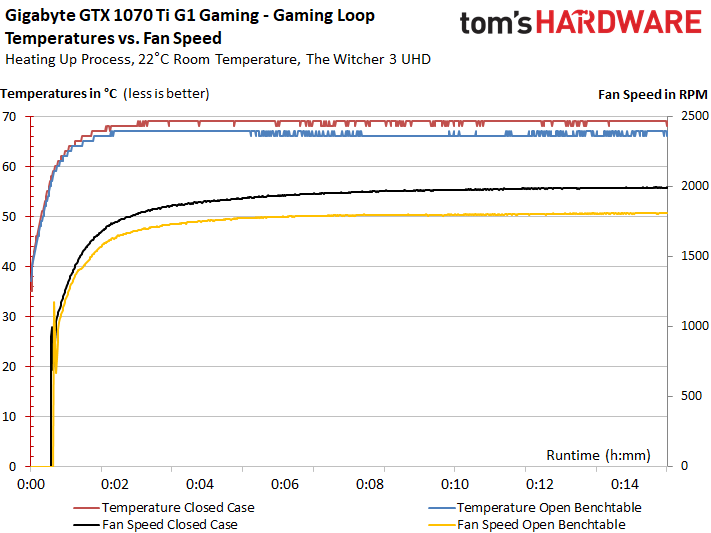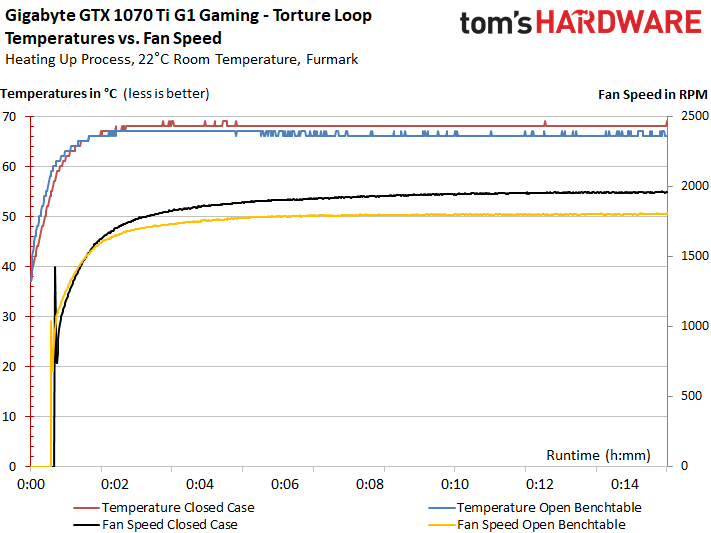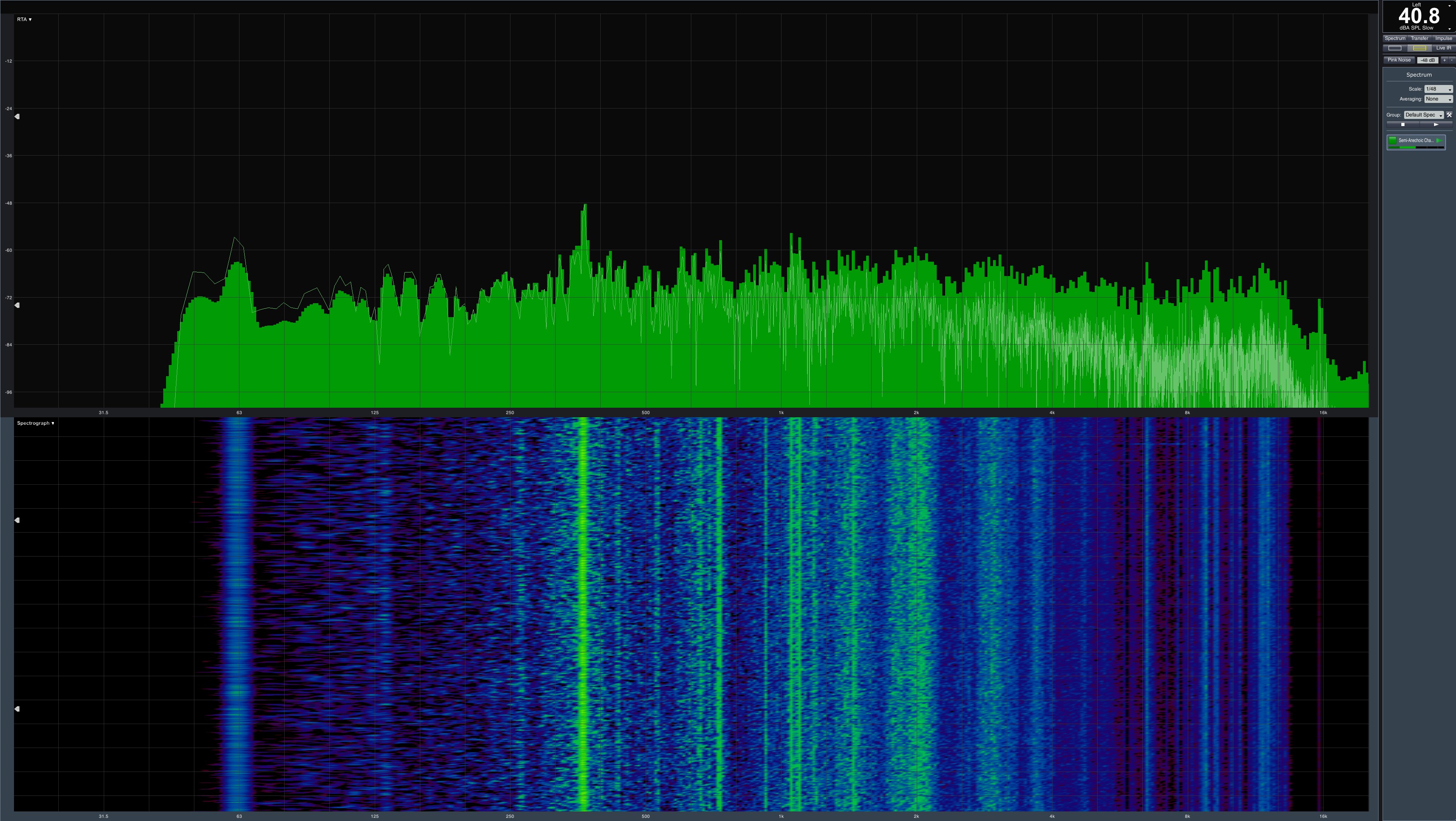Gigabyte GeForce GTX 1070 Ti Gaming 8G Review
Why you can trust Tom's Hardware
Cooling & Noise
Cooling System & Backplate
As mentioned, Gigabyte's backplate plays an active role in cooling this card. It's not just there to look pretty or add structural stability.
The foil has some cut-outs for thick thermal pads, which create contact between the backplate and PCB to help with voltage regulation circuitry cooling.
| Cooling System Overview | |
|---|---|
| Type | Air cooling |
| Heat Sink | Aluminum heat sink for GPU with heat pipes that make direct contactMemory cooling (modules, voltage converters) via mounting frame on heat sink |
| Cooling Fins | Aluminum, vertical orientationNarrow configuration |
| Heat Pipes | 2x 8mm, copper composite material |
| VRM Cooling | GPU-VRM via heat sink built in to coolerMemory VRM on the rear via backplate |
| RAM Cooling | Via mounting frame, and indirect cooling via heat sink |
| Fans | 3x 8cm fan module (7.7cm rotor diameter)11 rotor blades eachSemi-passive control |
| Backplate | AluminumCooling function, foil on the inside with cut-outs for padsRGB effects |
The GeForce GTX 1070 Ti Gaming 8G employs a simple finned cooler with a thick aluminum base plate, which also serves as sink and mount for the two flattened 8mm heat pipes. As you can see in the picture below, these pipes are only able to cover part of GP104. Might that be a sign attempts were made to cut costs?
Fan Speeds & Noise
Our fan data shows how Gigabyte compensated for the cooler's limited surface area with higher rotational speeds. A cynical reviewer might point out that big, beefy heat sinks cost manufacturers money, while power and noise become your problem at home. But there's something to be said for striking a balance, particularly when it comes to a high-end graphics card priced just $10 under the least-expensive GeForce GTX 1080.
Nothing much changes during our stress test. Armed with three rather small fans, it's almost impossible for this card to operate quietly. In the end, though, we aren't assailed by obtrusive noise levels.
The 1070 Ti Gaming 8G's thermal solution has no reserves left to facilitate lower fan speeds. Any attempt to dial down the curve would sacrifice at least one GPU Boost step in the process.
| Fan Speed & Noise Output | |
|---|---|
| Fan Speed (Open Test Bench, Maximum) | 1825 RPM |
| Fan Speed (Open Test Bench, Average) | 1802 RPM |
| Fan Speed (Closed Case, Maximum) | 2001 RPM |
| Fan Speed (Closed Case, Average) | 1992 RPM |
| Noise (Air Cooling, Maximum) | 40.8 dB(A) |
| Noise (Air Cooling, Average) | 40.2 dB(A) |
| Noise (Air Cooling, Idle) | 0 dB(A) |
| Acoustic Characteristics | Almost no low-frequency bearing noiseAudible motor noise <1 HzVery audible air/tearing noiseSlight voltage converter noise |
This snapshot illustrates the entire frequency range of our laboratory measurements, adding some data to our subjective observations.
Get Tom's Hardware's best news and in-depth reviews, straight to your inbox.
We're not at all impressed by an almost 41 dB(A) measurement. However, given how light this card is and the temperatures we observed, it's pretty remarkable that Gigabyte was able to use a solution from its GeForce GTX 1070 to address 1070 Ti as well. Cost-cutting can obviously be made to work, even if it has to be paid for with higher noise levels.
MORE: Best Graphics Cards
MORE: Desktop GPU Performance Hierarchy Table
MORE: All Graphics Content
Current page: Cooling & Noise
Prev Page Temperatures, Clock Rates & Overclocking Next Page Conclusion
Igor Wallossek wrote a wide variety of hardware articles for Tom's Hardware, with a strong focus on technical analysis and in-depth reviews. His contributions have spanned a broad spectrum of PC components, including GPUs, CPUs, workstations, and PC builds. His insightful articles provide readers with detailed knowledge to make informed decisions in the ever-evolving tech landscape
-
Cryio I'm still mostly impressed how the Vega64 is universally faster than 1080, same for Vega56 vs 1070.Reply -
derekullo Reply20526514 said:I'm still mostly impressed how the Vega64 is universally faster than 1080, same for Vega56 vs 1070.
The Geforce 1080 beats the Vega64 in Tom Clancy's Ghost Recon Wildlands at 2560x1440.
The Vega64 is also a 295 watt tdp card versus the 180 watt Geforce 1080.
A 60% increase in TDP to be 0 - 12% better is not very efficient.
https://www.techpowerup.com/gpudb/2839/geforce-gtx-1080
https://www.techpowerup.com/gpudb/2871/radeon-rx-vega-64
For completeness, the Geforce 1080 Ti is a 250 watt card.
https://www.techpowerup.com/gpudb/2877/geforce-gtx-1080-ti
On the other hand, Vega56/64 are both awesome monero miners even taking their 295 watt tdp into account.
https://whattomine.com/coins?utf8=%E2%9C%93&adapt_q_280x=0&adapt_q_380=0&adapt_q_fury=0&adapt_q_470=0&adapt_q_480=0&adapt_q_570=0&adapt_q_580=0&adapt_q_vega56=1&adapt_vega56=true&adapt_q_vega64=0&adapt_q_750Ti=0&adapt_q_1050Ti=0&adapt_q_10606=0&adapt_q_1070=0&adapt_q_1080=0&adapt_q_1080Ti=0ð=true&factor%5Beth_hr%5D=36.5&factor%5Beth_p%5D=210.0&grof=true&factor%5Bgro_hr%5D=38.0&factor%5Bgro_p%5D=190.0&x11gf=true&factor%5Bx11g_hr%5D=10.5&factor%5Bx11g_p%5D=230.0&cn=true&factor%5Bcn_hr%5D=1850.0&factor%5Bcn_p%5D=190.0&eq=true&factor%5Beq_hr%5D=440.0&factor%5Beq_p%5D=190.0&lre=true&factor%5Blrev2_hr%5D=13000.0&factor%5Blrev2_p%5D=190.0&ns=true&factor%5Bns_hr%5D=290.0&factor%5Bns_p%5D=160.0&lbry=true&factor%5Blbry_hr%5D=260.0&factor%5Blbry_p%5D=210.0&bk2bf=true&factor%5Bbk2b_hr%5D=1900.0&factor%5Bbk2b_p%5D=230.0&bk14=true&factor%5Bbk14_hr%5D=2600.0&factor%5Bbk14_p%5D=210.0&pas=true&factor%5Bpas_hr%5D=1350.0&factor%5Bpas_p%5D=230.0&skh=true&factor%5Bskh_hr%5D=36.0&factor%5Bskh_p%5D=210.0&factor%5Bl2z_hr%5D=420.0&factor%5Bl2z_p%5D=300.0&factor%5Bcost%5D=0.1&sort=Profitability24&volume=0&revenue=24h&factor%5Bexchanges%5D%5B%5D=&factor%5Bexchanges%5D%5B%5D=abucoins&factor%5Bexchanges%5D%5B%5D=bitfinex&factor%5Bexchanges%5D%5B%5D=bittrex&factor%5Bexchanges%5D%5B%5D=bleutrade&factor%5Bexchanges%5D%5B%5D=cryptopia&factor%5Bexchanges%5D%5B%5D=hitbtc&factor%5Bexchanges%5D%5B%5D=poloniex&factor%5Bexchanges%5D%5B%5D=yobit&dataset=Main&commit=Calculate
-
danielh1949 Stacking 4 Oscopes on top of a high shelf? are you serious? please reconsider, your work is worth reading.Reply -
FormatC Reply
What's the problem? Haven't you ever been in a lab before? The parts can be stacked and this is provided for by the manufacturer. Besides, everything's screwed down, don't worry. I need short signalling pathways to connect the scopes to each other, there are not many possibilities left. And - between you and me: when I'm standing in front of it, the top scope is barely at eye level. This is the art of photography, not a high shelf :D20526949 said:Stacking 4 Oscopes on top of a high shelf? are you serious? please reconsider, your work is worth reading.
If you don't have any problems, you can build your own... ;)
-
danielh1949 Reply
Just concerned about your safety, and I've built enough of my own; but I see from your picture that I need not be concerned. Nice setup, as long as it's safe. I look forward to interesting reading. I'd especially like waveform comparison of the current PCI with the new bus they're considering as the replacement. The whole waveguide multilayer PC board is nearly as interesting as Walsh codes. Merry Christmas and Happy New Year. Hope it's better than this one was. Old Lang Syne is gaining new meaning to me. Dan20529267 said:
What's the problem? Haven't you ever been in a lab before? The parts can be stacked and this is provided for by the manufacturer. Besides, everything's screwed down, don't worry. I need short signalling pathways to connect the scopes to each other, there are not many possibilities left. And - between you and me: when I'm standing in front of it, the top scope is barely at eye level. This is the art of photography, not a high shelf :D20526949 said:Stacking 4 Oscopes on top of a high shelf? are you serious? please reconsider, your work is worth reading.
If you don't have any problems, you can build your own... ;)
-
FormatC Have you ever been to the lab in China? What is the screw for the German and the glue for the American is the cable tie for the Chinese. It's all very optimistic (ok, it looks so), but it's (mostly) holding up well. :DReply
I wish you also a happy new year and have a nice time. :) -
danielh1949 Reply20533302 said:Have you ever been to the lab in China? What is the screw for the German and the glue for the American is the cable tie for the Chinese. It's all very optimistic (ok, it looks so), but it's (mostly) holding up well. :D
I wish you also a happy new year and have a nice time. :)
My uncle, Herr Professor, sent me German Erektor Sets for my earliest birthdays (or so I seem to remember), Your question brought to my mind a vision of an erector set tower held together by wire ties.:pt1cable: I guess it would be good for an earthquake, although I would not like to be on it at that time.




